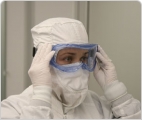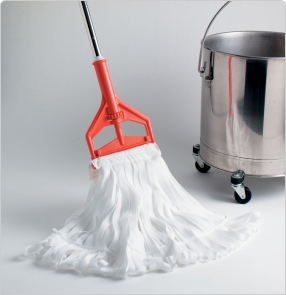What is a Clean Room? – Definitions and Methods
What is a Clean Room – Definitions and Methods
Manufacturers, science laboratories, and any setting needing a rigorously controlled environment will rely on what is known as a cleanroom. These pristine rooms are integral to successfully designing, producing, and handling the most sensitive products and processes that drive the growing world economy. Special practices and protocols govern all clean room staff and handling of clean room supplies.
The goal in every clean room is to maintain an extremely low level of airborne pollutants, with specific levels and ratings prescribed for different processes, and for the various possible contaminants, such as dust, microbes, chemical vapors, and aerosol particles.
Where Are Clean Rooms Needed and How Are They Controlled?
Common standards for cleanrooms are established by the International Standardization Organization, or ISO. Cleanrooms are classed according to the ISO level of control required for their certification and operation in each field. A room is classified according to the number of particles equal to or greater than 0.5mm per cubic foot of air, or in the ISO 14644-1 Standards, according to the number of particles 0.1 µm or larger per cubic meter of air.
Contamination is monitored, for the most part, by measuring air particulates, an indication of just how crucial proper air flow is to maintaining a pristine cleanroom environment. The design of air flow mechanisms combines factors that affect directional flow into the room, and downstream air returns. A steady stream of single direction air flow is directed downward into the room, through either HEPA or ULPA filters.1
Cleanroom Supplies

A rigorous set of processes maintains cleanroom standards through monitoring the cleanliness of equipment and machinery used in the room, and of products or components introduced to the room. In most settings, sterile practices extend to the supply and storage areas for cleanroom supplies that will be brought into the room. Access to storage areas is limited and controlled to further reduce the possibility for contamination and to facilitate tracing any problems to their source.
Specific cleanroom supplies, like sterile reusable mop systems and sterile reusable goggle programs, are available from specialized sources like Prudential Overall Supply through their specialized Cleanroom Services. Both of these items are an important part of cleanroom protocol. They are manufactured to very specific standards and are costly to replace. Sterile, reusable goggles and mop systems provide a convenient method for avoiding the negative factors of environmental impact and waste, while reducing overall costs.

Maintaining Clean Room Standards
Biotech, medical device, and pharmaceutical manufacturers in particular offer insight into the need for successful sterile practice in clean rooms, and the possible consequences of inadequate vigilance. The quality of the end products made in these rooms can ultimately be a factor in life-and-death scenarios, so they set a high standard for training staff in cleaning surfaces and machinery, in gowning procedures, and in methods for safely handling components used in the room.
The spread of dangerous molds is said to be on the increase, and they are easily transferred and difficult to eliminate. Among the molds detected are some bad actors like aspergillus, trychophyton, and penicillium. These have been known to travel on sources such as marker pens, boxes, cart wheels, and others.
Once detected, these molds and fungi set off a chain of events from extensive testing, tracing, and monitoring, to elimination procedures using some combination of germicides and disinfectants, which may require a variety of application methods for use on sheet rock and surfaces behind walls, as well as on exposed surfaces, equipment, and in airflow systems.2
The Human Factor in Cleanrooms
Predictably, the human factor is potentially the most damaging to a room’s cleanliness, so personnel who enter and leave wear special cleanroom work clothes. Employees follow a careful routine as they prepare or dress (called “gowning”). In most settings, they change into their sterile workwear in a special gowning room, then enter and leave the clean room through an airlock or air shower chamber.2
Cleanroom garments themselves may be sources of contamination if not properly processed, delivered, and stored on-site. As a result, suppliers of garments and of cleaning services must also meet standards for certification. Accepted procedures for suppliers, like Prudential Overall Supply, who provide cleaning, packaging, and delivering of cleanroom garments, are themselves rated and governed by the same ISO standards as those they serve. ISO Class 3 rating for cleanroom garment processing facilities means they are validated for sterile garment processing to serve particulate, aseptic, and ESD controlled environments.
Cleanroom Garments

Proper cleanroom attire is designed to trap and prevent human contaminants, such as those generated by the skin and body, or carried in on their own garments, from entering the clean environment. The procedures for gowning vary somewhat by industry, but in general, they follow a procedure of “donning” (putting on sterile cleanroom garments) prior to entering, and “doffing” or “de-gowning” (removing special cleanroom garments after exiting), similar to the following:
- Wash and dry hands, then enter general gowning area or room;
- Place bouffant over hair, making sure no stray hairs are left uncovered;
- Walk across tacky mat;
- Place disposable shoe covers over shoes;
- Put on donning gloves;
- Enter sterile gowning area;
- Slide hood over bouffant, covering hair completely;
- Attach snaps in back; don face mask;
- Don coverall without letting it touch floor, one leg then one arm at a time; zip up; fasten snaps at ankles and collar;
- Don boots and snap;
- Don goggles or face shield;
- Either replace first pair of donning gloves and replace, or place second pair over first and cover sleeve cuffs.
The doffing sequence reverses the above procedure. Used items are disposed of or placed in recycling receptacles.3
Proper cleanroom attire also serves to protect employees from potential harm in many settings. Working with harsh chemicals, airborne dust, or microbes without protection may place their health at risk. Cleanroom garments usually provide head-to-toe coverage, including boots or boot/shoes covers, a zipped coverall or frock, face mask, and sleeve cover. Different garment configurations and fabrics are tested and rated by independent laboratories for use in various industries such as aerospace, medicine, and electronics.
1. http://www.cleanairtechnology.com/cleanroom-classifications-class.php
2. https://www.rdmag.com/article/2007/09/control-strategies-fungal-contamination-cleanrooms
3. https://www.rdmag.com/article/2014/01/basic-cleanroom-gowning-procedures
To find out more information about cleanroom services, contact Prudential Overall Supply at (800) 767-5536.